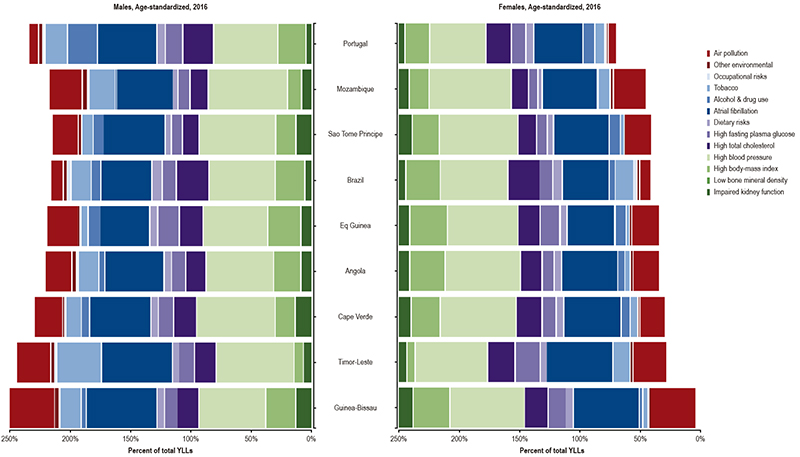Volume 110, Nº 6, June 2018
DOI: http://www.dx.doi.org/10.5935/abc.20180098
ORIGINAL ARTICLE
Cardiovascular Disease Epidemiology in Portuguese-Speaking Countries: data from the Global Burden of Disease, 1990 to 2016
Bruno Ramos Nascimento
Luisa Campos Caldeira Brant
Gláucia Maria Moraes de Oliveira
Marcus Vinícius Bolívar Malachias
Gabriel Moreira Alves Reis
Renato Azeredo Teixeira
Deborah Carvalho Malta
Elisabeth França
Maria de Fátima Marinho Souza
Gregory A. Roth
Antonio Luiz P. Ribeiro

Figure 7 – Influence of the risk factors on the years of life lost (YLLs) because of cardiovascular diseases, according to sex, in each Portuguese-speaking country in 2016.
Abstract
Background: Portuguese-speaking countries (PSC) share the influence of the Portuguese culture but have socioeconomic development patterns that differ from that of Portugal.
Objective: To describe trends in cardiovascular disease (CVD) morbidity and mortality in the PSC between 1990 and 2016, stratified by sex, and their association with the respective sociodemographic indexes (SDI).
Methods: This study used the Global Burden of Disease (GBD) 2016 data and methodology. Data collection followed international standards for death certification, through information systems on vital statistics and mortality surveillance, surveys, and hospital registries. Techniques were used to standardize causes of death by the direct method, as were corrections for underreporting of deaths and garbage codes. To determine the number of deaths due to each cause, the CODEm (Cause of Death Ensemble Model) algorithm was applied. Disability-adjusted life years (DALYs) and SDI (income per capita, educational attainment and total fertility rate) were estimated for each country. A p-value < 0.05 was considered significant.
Results: There are large differences, mainly related to socioeconomic conditions, in the relative impact of CVD burden in PSC. Among CVD, ischemic heart disease was the leading cause of death in all PSC in 2016, except for Mozambique and Sao Tome and Principe, where cerebrovascular diseases have supplanted it. The most relevant attributable risk factors for CVD among all PSC are hypertension and dietary factors.
Conclusion: Collaboration among PSC may allow successful experiences in combating CVD to be shared between those countries. (Arq Bras Cardiol. 2018; 110(6):500-511)
Keywords: Cardiovascular Diseases; Epidemiology; Mortality; Global Burden of Disease / trends.















